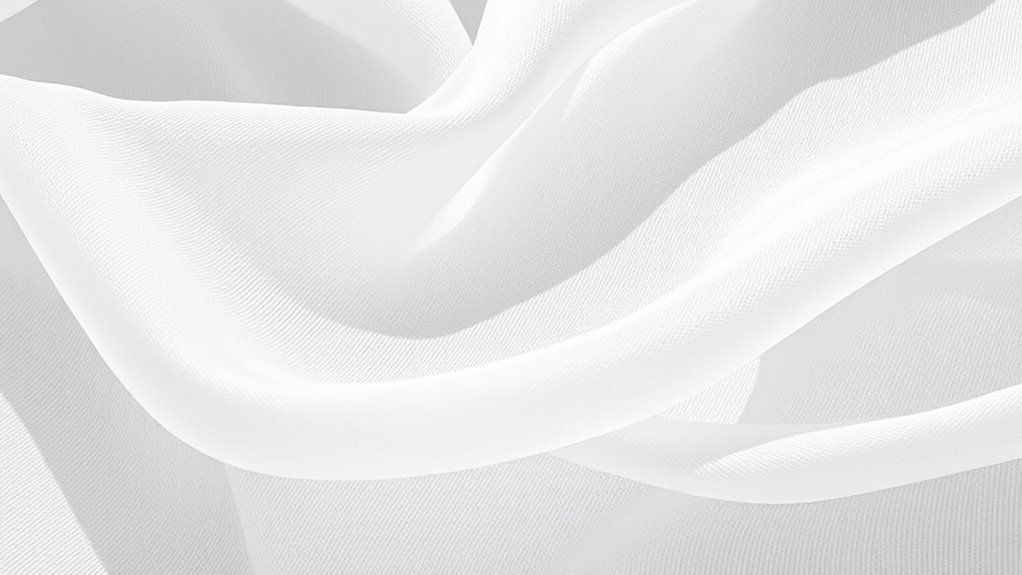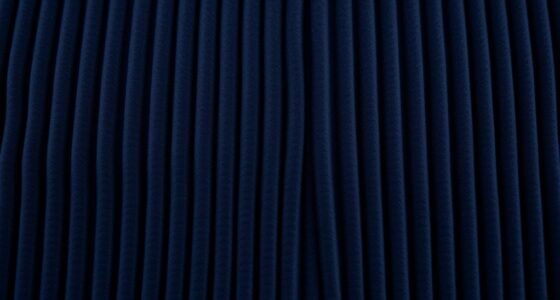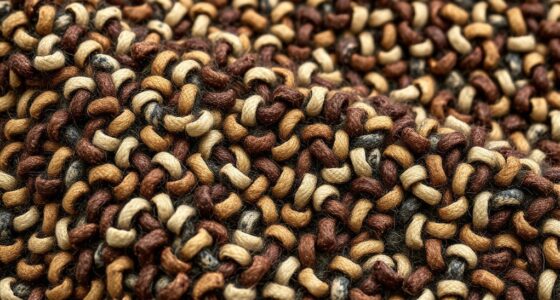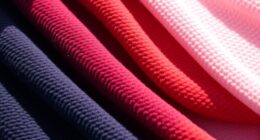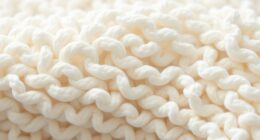Georgette is a lightweight crepe fabric known for its textured surface and elegant drape. Originally crafted from silk in early 20th-century France, it’s now made from fibers like polyester and chiffon blends, offering affordability and durability. Its unique twisted yarns create a crinkled look that flows effortlessly, making it perfect for sarees, blouses, and evening wear. To discover more about its rich history and craftsmanship, keep exploring what makes georgette so special.
Key Takeaways
- Georgette is a lightweight crepe fabric originally made from silk, known for its textured, crinkled surface and elegant drape.
- It is woven with twisted threads on a plain weave loom, enhancing its textured appearance and flowing feel.
- Modern georgette incorporates fibers like polyester and chiffon blends, making it versatile and cost-effective.
- Its semi-translucent quality and textured surface make it ideal for sarees, blouses, and evening wear.
- Georgette’s rich history and craftsmanship continue to influence contemporary fashion with its blend of elegance and comfort.
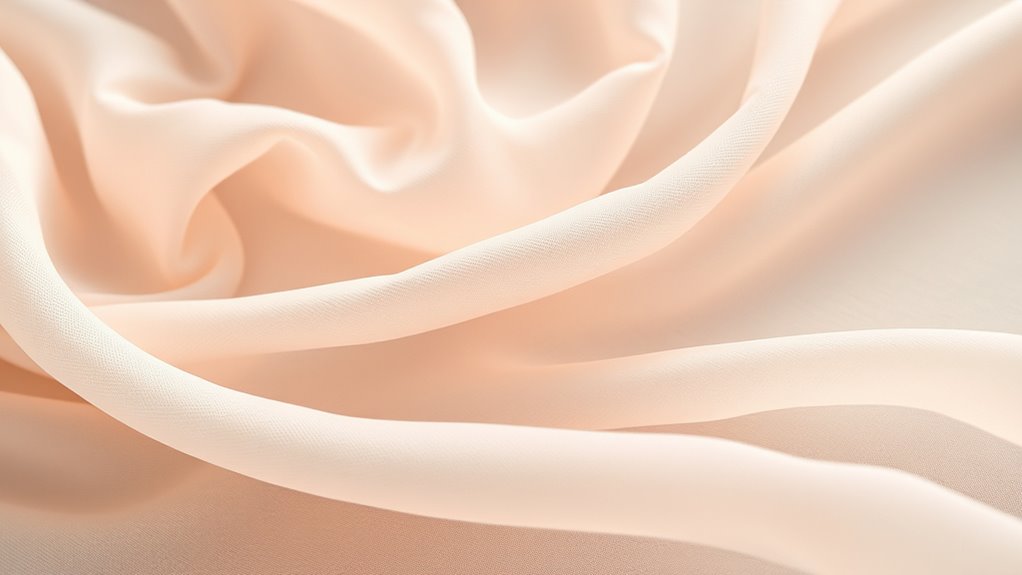
Have you ever wondered what makes Georgette fabric so special? To truly appreciate this lightweight crepe fabric, it helps to understand its fabric history and the manufacturing techniques that give it its unique character. Georgette’s origins trace back to the early 20th century in France, where it was initially crafted from silk. Its name is believed to be derived from the French actress Georgette de la Plante, who popularized the fabric through her elegant designs. Over time, the fabric’s popularity expanded, and today, it’s produced from various fibers like silk, polyester, and chiffon blends, making it versatile for different styles and budgets.
Discover the rich history and craftsmanship behind Georgette, a versatile and elegant lightweight crepe fabric.
The fabric history of Georgette is rooted in the traditional weaving techniques that define its texture and appearance. Originally, it was woven on a plain weave loom but with a twist—its threads are twisted in a way that creates a slightly crinkled, textured surface. This distinctive surface is the result of the manufacturing techniques employed during its creation. During the weaving process, the warp and weft threads are twisted tightly before weaving, which causes the fabric to have a slightly crinkled look even before any treatment. This twisting not only gives Georgette its signature texture but also contributes to its lightweight, flowing drape. The fabric is then finished with a process called “fulling,” which tightens the fibers and enhances its durability, while still maintaining the delicate feel.
Manufacturing techniques for Georgette emphasize precision and skill. The twisting of the yarns is a critical step—if done too loosely, the fabric loses its characteristic texture; too tight, and it becomes stiff. Once woven, the fabric undergoes finishing processes such as washing and heat-setting to stabilize its texture and shape. Modern manufacturing may incorporate synthetic fibers to produce cost-effective and durable versions of Georgette, but the fundamental techniques—twisting yarns, weaving on a plain loom, and finishing—remain consistent. These techniques ensure the fabric retains its lightweight, semi-translucent quality, which makes it so appealing for elegant garments like sarees, blouses, and evening wear. Additionally, the versatility of fibers used in making Georgette allows for a range of textures and appearances, from matte to slightly glossy finishes.
Understanding the fabric history and manufacturing techniques behind Georgette highlights why it’s so prized in fashion. Its textured surface, achieved through meticulous craftsmanship, offers an effortless combination of elegance and comfort. Whether made from silk for luxury or polyester for affordability, the essence of Georgette remains rooted in centuries-old traditions of weaving and finishing that continue to influence its design today. So, next time you see a flowing gown or a delicate scarf, remember the centuries of craftsmanship and history woven into every thread of Georgette.
Frequently Asked Questions
How Does Georgette Compare to Chiffon in Texture?
You’ll notice that georgette has a slightly more textured, crisp feel compared to chiffon’s smooth, soft texture. Georgette is generally more durable and better at retaining color over time, making it ideal for long-lasting garments. Chiffon, while lightweight and flowing, can be more delicate and may fade faster. Both fabrics look elegant, but georgette’s sturdiness and color retention give it an edge for more structured designs.
Can Georgette Fabric Be Used for Outdoor Wear?
You can use georgette fabric for outdoor wear, but keep in mind its outdoor durability and weather resistance are limited. Imagine strolling through a breezy park with the soft, flowing texture of georgette moving around you. While it’s lightweight and elegant, it’s not ideal for harsh weather. For better outdoor performance, choose fabrics specifically designed for weather resistance, like nylon or polyester blends.
What Are the Best Laundering Methods for Georgette?
You should dry clean georgette to keep it looking its best, but hand washing is also a gentle option. If you opt for hand washing, use cool water and a mild detergent, then gently swirl the fabric without wringing. Avoid bleach and harsh chemicals, and lay the fabric flat to dry. These methods help maintain georgette’s delicate texture and vibrant color over time.
Is Georgette Suitable for Both Casual and Formal Attire?
Yes, georgette is suitable for both casual and formal attire because of its style versatility and dress suitability. You can create chic, flowing dresses for elegant events or casual tops perfect for everyday wear. Its lightweight and textured appearance make it adaptable for various looks, allowing you to dress up or down effortlessly. With the right styling, georgette seamlessly shift from relaxed daywear to sophisticated evening outfits.
How Does the Breathability of Georgette Vary With Different Weaves?
The breathability of georgette varies with its weave density; a looser weave allows better airflow, enhancing moisture management and keeping you cooler. Conversely, a denser weave restricts airflow, making it less breathable and potentially trapping heat and moisture. When choosing georgette, consider the weave density based on your activity or climate, so you stay comfortable. Lighter weaves are ideal for hot weather, while tighter weaves suit cooler environments.
Conclusion
Now that you’ve uncovered the beauty of Georgette, you see it’s more than just lightweight fabric—it’s a versatile gem for any wardrobe. Its flowy drape and delicate texture make it perfect for both casual and elegant styles. Remember, don’t judge a book by its cover; Georgette’s true charm lies in how it feels and moves with you. Once you try it, you’ll realize it’s a fabric that truly stands the test of time.
